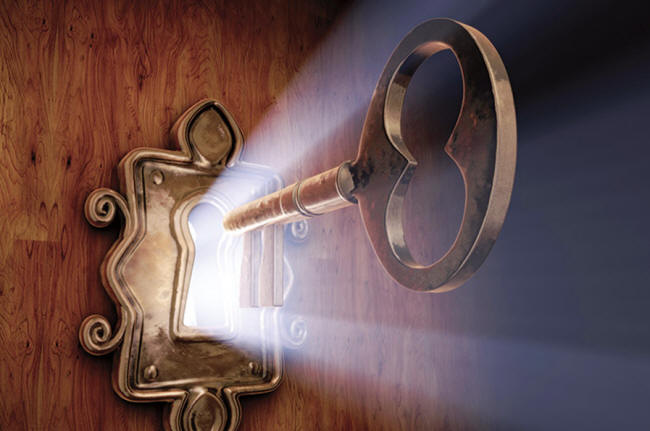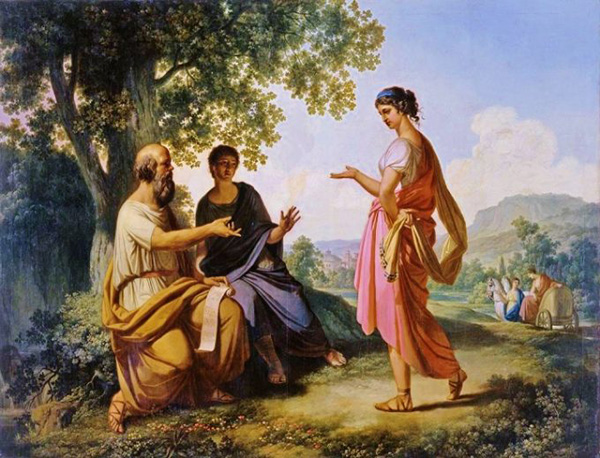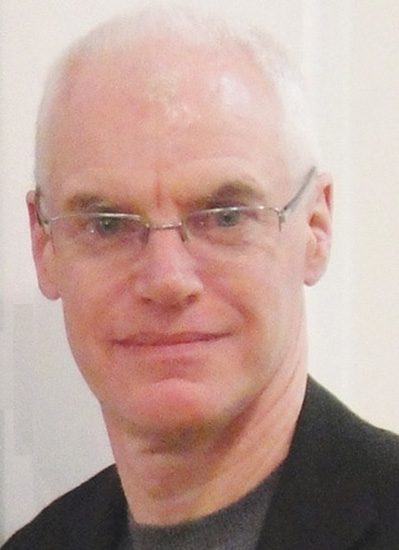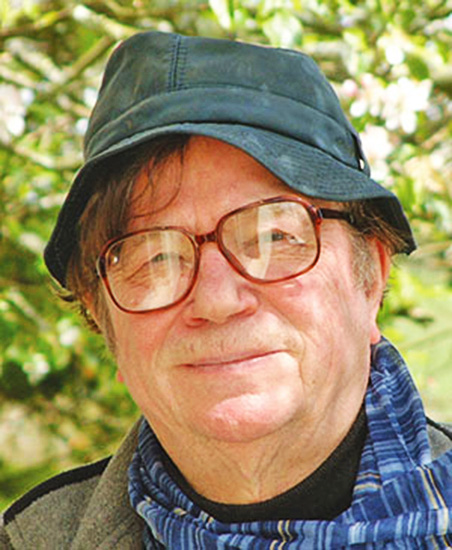|

by David J. Moore
New Dawn
Special Issue
Vol 13 No 5
(October 2019)
from
NewDawnMagazine Website
Spanish version

Are 'meaningful
coincidences' and a sense of déjà vu signs of a 'higher
self' - another secret you?
If so, could this
be the key to magic and even art?
These two questions have
over a millennia's long pedigree...
From Plato,
Socrates, Carl Jung to modern Hollywood movies. But for
you and me, they may hold the key to understanding life's most
miraculous moments.
Bridges
Between Time
In Plato's
Symposium, the ancient Greek
prophetess
Diotima of Mantinea says to
Socrates that love is a "great daemon."
She elaborates, saying
that,
"everything daemonic
is between divine and mortal."
In other words, a Daemon
appears to be a 'bridge' between two realities, between two levels
of time,
'mortal time' and
'divine time', or eternity...

"Socrates with disciple Diotima,"
painted
by Franz Caucig, 1810.
The
ancient Greek prophetess Diotima of Mantinea
said to
Socrates that love is a "great daemon,"
and
that "everything daemonic is between
divine
and mortal."
Over time, the word
Daemon has come to be understood - or
misunderstood - as meaning an evil spirit or devil.
Now that is not to say that evil spirits and forces don't exist (I
like to be open on the issue).
But in pre-Christian
ancient Greece, the word Daemon meant something more benign.
It meant a 'tutelary
deity', a type of Guardian Angel...
Diotima was an early
challenger of this notion, however, insisting that it was something
much more profound.
As we'll see, the Greek prophetess was ahead of her time.
Peake's Daemon
- Our Secretive Silent Self
More recently, the author
Anthony Peake explored the
mystery of the Daemon in his book
The Daemon - A Guide to your Extraordinary
Secret Self (2008).
Peake argues that the
Daemon is an aspect of our psyche whose domain is within our
non-dominant hemisphere of the brain (i.e. the right). It exists, he
claims, in a state outside of linear time.
The Daemon is also
silent; it has no access to the speech centers of the brain, which
are in the left hemisphere, or the 'dominant hemisphere'.

Author & original thinker
Anthony
Peake
Peake argues convincingly that the Daemon is a silent observer
who has a wholly different perspective on our lives.
It may even
know our individual destiny, and those of others...
In
Daimonic Reality - A Field Guide to the Otherworld (1994),
the philosopher
Patrick Harpur
makes some further
distinctions that help us understand some of its qualities.
He roughly divides the
human mind into two types of ego.
Our everyday sense of
identity which lives in mortal time - and which we refer to as
'I' or 'me' - is what he calls the rational ego.
Our rational ego confers upon us a sense of continuity in time.
Our other self is, too, an ego - with its own identity - but
with crucial differences.
He says that the Daemon
is,
"not of
consciousness, but of the unconsciousness."
The Daemon is also,
"not a waking, but a
dream ego; not a rational, but an irrational ego",
...an ego he calls the
Daimonic Ego (Peake's Daemon). 1
Now, this brings us to the other topic of this article:
synchronicity.
The Swiss psychologist Carl Jung coined the word
synchronicity. It refers to those
odd moments in life when the inner world of the mind is reflected in
the outer world as an event.
We call these
'coincidences'...
What makes Jung's
synchronicity different from a coincidence is that they are
meaningful to the observer.
Thus, synchronicity
simply means 'meaningful coincidence' - a confluence of inner and
outer events that seem to converge into a singular moment.
Synchronicities appear as if matter and mind 'came together' for a
brief moment.
But, as I will argue in this article, they may be
interventions from our Daemonic minds.
Books That
Find You - Two Synchronicity Cases
As an example of typical synchronicity, I will use my own case.
In fact, it inspired me
to pursue the themes explored in this article.
A few years ago I was walking into Stourbridge Town in the West
Midlands to do some shopping. For a reason I have forgotten, I was
talking to my friend about the Austrian esoteric philosopher
Rudolf Steiner.
I had to admit I didn't
know much about him despite having read a few books which referenced
his work.
Before long I asked aloud:
"What are the fruits
of his philosophy, Anthroposophy?"
(I am paraphrasing,
but I remember using the words' fruits of Anthroposophy'.)
Nonetheless, we continued
walking, and as we approached a charity shop, we decided to
investigate. The shop was small and generally over packed with
clothes and other bric-a-brac.
There was a small book
section in the corner.
I glanced over it, and immediately a book grabbed my attention.
The
Fruits of Anthroposophy by Rudolf Steiner!
Immediately I bought it, taking it as a sign - from a dimension
unknown - that I ought to read more about Anthroposophy.
Before we unpack the implications of the synchronicity and the
Daemon, let's turn to another synchronicity.
This time by one of the
world's most prolific British writers on occultism and
existentialism, the late Colin Wilson.

Colin Wilson (1931–2013)
(Photo
credit: Simon Brighton)
Again, it concerns a book.
He was writing an article about the subject of synchronicity for
An Encyclopedia of Unsolved Mysteries (1987). Shortly afterwards
he experienced a profound synchronicity.
He said that it seemed so
"preposterous" that it defied the ordinary definition of a
coincidence.
For his article, he described a synchronicity that happened to the
French ufologist
Jacques Vallee.
Vallee had been
researching a Los Angeles-based religious cult. Its name, the
Order of Melchizedec, termed after an obscure biblical
prophet.
Vallee had been attempting to find more information about the
cult but with little success.
At some point during
his search he took a taxi to Los Angeles airport. To his
astonishment, the taxi driver who gave him his receipt signed it
'M. Melchizedec'.
And whom, it turned
out, was the only Melchizedec in the enormous Los Angeles
telephone directory.
Wilson must have thought
this an impressive synchronicity, enough to include in his
encyclopaedia.
But the universe - or his
Daemon - seemed to think one better.
He says that after he finished writing his passage on Vallee's
remarkable story, he broke off to take his dogs for a walk.
He continues:
"As I was leaving my
workroom, I noticed on the camp-bed a book that had obviously
fallen off the shelf, and which I did not recognise.
It was called You
Are Sentenced to Life, by a Dr W.D. Chesney, and I had
obviously bought it many years before in California and sent it
for binding.
But I had never
actually read it. When I came back from my walk, I glanced
through the book - and discovered, at the very end, a page
headed ORDER OF MELCHIZEDEK." 2
Now the question that
haunts us in these moments of meaningful coincidences is:
"Well, what does it
all mean?"
In each instance above,
there is a sense that it is confirming a thought, as it were, rather
as if some force is reminding us that we're on the right path.
Wilson's account seems to
say,
'Yes, synchronicities
do happen, and if you think Vallee's is impressive, how about
this…'
And then this mysterious
'force' ensures that the right book is brought to Wilson's
attention.
After such an experience,
it is almost impossible to shake off the conviction that the
universe is a far stranger place than we take for granted.
Hallmarks of
Another 'You'
So, where does the Daemon fit into all this?
The Daemon, as we
have seen, is the unconscious and non-rational ego lying silent
in our non-dominant hemisphere of the brain.
And if anything is
non-rational, then it is the synchronicity that Jung described
as an "acausal connecting principle" (indeed an irrational
description which simply means a cause that is not a cause!).
In The Many Faces of
Coincidences (2017), Laurence Browne says,
"[there is an]
uncanniness that often accompanies these experiences, as if an
ancient memory of the mysteriousness and inter-connectedness of
life is suddenly and unexpectedly evoked." 3
Based on the above cases,
this seems to be true enough.
Could it be that this
other-self, the Daemon, is somehow involved in these unusual
experiences?
And, as it exists
without access to our speech centers, is the synchronicity a
mode of its expression?
An expression, after all,
that appears to lie outside time and space in the ordinary sense.
And which - much like
what Diotima said to Socrates,
appears to exist between two levels
of time, mortal and divine...
Veronica Goodchild, author of Songlines of the Soul
(2012), believes that synchronicities are "moments of epiphany"
designed to slow us down.
They act to bring us into
the present moment, providing us with a glimpse of "another world in
the ordinary one." 4
The Daemon, I would argue, seems a likely candidate for this other
self - or force - that comes into our lives in moments of
synchronicity or
déjà vu.
We can see that our
minds split into two complementary parts - into a rational ego
and Daemonic ego.
We can also see that
in these moments we experience reality through two perspectives.
This also answers the
sense of uncanniness that soon accompanies synchronicity.
Seeing the
world in a state of 'double-exposure', as it were, reality itself
appears to curiously overlap with another world.
Worlds
Together, Towards an Occult Psychology
Indeed, a simultaneity of two worlds coming together is its most
reported impression.
Moments in which the
inner world of the mind seems to link up with the outer world. It
appears nothing less than magical.
Jeffrey Kripal,
the Chair of Philosophy and Religious Thought at Rice
University, says that synchronicity,
"[is] essentially a
shiny new word for what we would have earlier called magic."
The difference between
magic and synchronicity experiences is more in degree than kind.
Magic infers the will of
a magician to affect change in himself or the environment. It is an
active means to create synchronicity, of manipulating time and space
under one's desires.
But synchronicity appears
in unexpected moments, accounting for the initial surprise - the
shock of seeing reality conform to one's thoughts.
Yet is this true?
In both examples above, synchronicity often
appears when we're intensely thinking about something. It may bother
or even obsess us, whether consciously or otherwise.
Many such cases of
synchronicity can be found in books like Trish and Rob MacGregor's
The Synchronicity Highway (2013) or Raymond E. Fowler's
Synchrofile
(2004).
Wilson's experience is a case in point.
He was writing and intensely
thinking about synchronicities for his encyclopedia entry. The
event seems related; the book that fell off his shelf was relevant
to what he was thinking and writing about at the time. And in my own
experience, too, it was related to my desire to know more about
Rudolf Steiner's philosophy.
The Daemon appeared to
confer this opportunity.
Once we begin to think about the synchronicity experience in more
depth, we see that it is what only a few centuries ago we would have
called magic.
Again, to return to
Wilson's example, we can see that there might be an element of
mind-over-matter - or psychokinesis - involved.
He managed to somehow
unconsciously will the book to fall from the shelf. He also seemed
to know on a deeper level - perhaps in the Daemonic mind - that this
book contained the chapter he required and that he would return to
find it.
The late physicist F. David Peat suggested it is the degree and
sensitivity of mind that makes one open to the synchronicity
experience.
He said that a mind in,
"constant process of
creative change… will respond to the overall patterns of nature
so that the individual can enter into these patterns in new
ways." 5
There are moments in life
when we are far more open than usual to 'creative change'.
We could call these
moments of intersection important events that shape our lives,
pushing it in one direction or the other. Taking a risk is often a
good example and one in which we often consciously look for 'signs'
that a risk is worth taking.
We look for omens or
portents which may foretell the future - good or bad - of our
choices.
Authors Trish and
Rob MacGregor describe the beauty of taking such risks lies
in its galvanizing of our unconscious elements.
These rise to the
surface of our rational ego - our everyday consciousness - allowing
us to evolve, to challenge ourselves.
There are, alas, darker moments in our lives when we ask for
guidance, and we appear to receive it - or, sadly, we don't.
Let's say we do receive
something apparently miraculous.
Say, a synchronicity or omen that
appears uncannily unlikely:
Is it merely
pathological?
A desperate attempt
to force reality to mean something but, in reality, is simply
our mind playing tricks on us?
In the Domain
of the Muse - Magic, Art and Creativity
At this point, these questions become very interesting.
As we have seen, our
silent partner, the Daemon, lies apparently dormant within our
psyche and seems to intercede in moments of heightened importance.
It as if we call forth
our unconscious self in moments of risk, radical change, or "Dark
Nights of the Soul."
Anthony Peake also makes the argument that the Daemon is our self
that has already lived our lives before, in a sort of Eternal
Recurrence. Our sense of déjà vu is, he argues, a recognition to our
everyday self of a return, a re-run of our lives that feels eerily
familiar.
We feel, for a fleeting
moment, the presence of the Daemon in our minds.
The corollary of this, of course, would be that to practice magic is
to take risks and seek out ways of creating moments of transitions
in our lives; in developing moments of intersection that forces our
unconscious Daemon into manifesting.
It would be reassuring to think we could work closely with a 'Self'
that has, after all, lived our lives before.
We could improve our own
lives and those of others. Although relying too much on risks and
shocks, of course, harbours many implicit dangers.
We would, of course,
unconsciously create needless and uncontrollable chaos in our own
lives.
Indeed, it reminds of that old proverb:
"Be careful what you
wish for."
Our conscious, 'rational'
selves often make the wrong choices after all; not knowing what is
best for us.
A subtler and gentler approach may be more suitable. In situations
of risk and crisis, the Daemon may appear to scream out, imbuing our
lives with signs and synchronicity.
But there are also its more
generative and beautiful dimensions. These imbue and saturate
our art and appear in moments of heightened creativity.
Both rely heavily on moments of vision and intuition, of flashes and
influxes of inspiration. In short, we're now in the domain of the
Muse, that Daemonic 'in between'.
Shakespeare said that the
Muse gives,
"forms of things
unknown [a] local habitation and a name."
The imagination, so
crucial to magic, here transmutes the invisible world of the Daemon
into the here-and-now.
We see it in forms of
art, poetry, sculpture, dance and music. This, in itself, is a
method of generating synchronicity. Dance is a synchronized
performance - usually to music - expressing on one level that which
is in implicit in the mind of the dancer.
It becomes explicit -
actual - in the form of the dance. In essence, the whole dance lies
complete in the mind of the individual (unless it is, of course,
improvised).
The dance then unfolds
again, in time, as a performance.
Again, magic is related to the arts (black magic is referred to as
the 'black arts'; white magic is often called the Hermetic Art). One
need only turn to books on alchemy to see that it is often referred
to as 'The Great Work'.
Usually equated with
forming gold out of base elements, in esotericism and psychological
theory it symbolizes the transformation of the individual's psyche.
We may here replace 'base elements' as that of unconscious
processes.
Those aspects of ourselves that are unknown, even primal.
Their elevation - through
transmutation - become higher forms such as art, music and dance;
the 'gold' of the alchemists.
Synchronicities, then, become life's most artful expressions.
They
show themselves in a marriage between two realities:
that of the
rational ego and the Daemonic ego.
These are the converging
of the rational and irrational; conscious and unconscious. And as we
have seen, this can be understood as magic in its microcosmic form.
That in which the
implicit becomes explicit; the subjective - or thought, feeling,
sensation - becomes the objective. The manifest event that happens
in 'real time' and is directly experienced.
The magician, of course, would see synchronicity as confirmation of
his deep intent played out in the world. An artist also attempts to
bring out what exists within the imagination. And once the canvas,
sculpture or musical arrangement is actualised to satisfaction, it
'feels right'.
It provides a pleasing
quality of completeness both in the artist and hopefully to other
people, even culture at large.
The Daemon appears to exist within this realm of art and
possibility; in short, the imagination. But it is not the
imagination of mere fantasy and fancy.
It is instead the possible
and latent realities, even evolutionary potentialities.
The full actualisation of
the Daemon into ordinary consciousness would effectively make one a
superman or a madman.
This would depend on the
level of integration of one's personality and self-discipline.
A
poorly integrated person would fly apart if his unconscious
processes suddenly made themselves too explicit.
As already mentioned, the Daemon appears to have access to our lives
already lived.
It has, at some point, 'been us' and gone through all
our trials and tribulations. In psychological terms, it would be
called our super-ego or our Transpersonal Self.
Patrick Harpur
adds that the,
"unconscious, soul,
imagination - whatever model we use - are in themselves
non-spatial, just as they are timeless." 6
Dreams, art, intuitions,
synchronicities and omens...
all are part of the magician's and
artist's toolkit.
All are the product of a
timeless zone.
Indeed, we often call a piece of awesome music
'timeless' for its sense of forever being new, interesting and
inspiring.
It's almost as if the
artist tapped into some wellspring of creative force recognised by
some deeper part of ourselves. It moves us, brings us to emotional
heights, and places us in another state of consciousness.
Heightened states of emotion, says occult historian Mitch
Horowitz,
"[are] the ideal
state for using affirmations and visualisations to impress the
subconscious and spur subtle abilities of thought." 7
But instead of imagining
ourselves in some occult ritual to artificially evoke these
heightened emotional states, we may turn to an everyday example.
Our next artistic symbol
pulls together all the threads of this article into a modern myth.
It is an eminently practical and timeless classic of popular
entertainment.
Eternal
Returns, Hollywood Style
The movie
Groundhog Day (1993) stars Bill
Murray as Phil Connors, a cynical TV weatherman who is sent to cover
the annual event of the movie's namesake in Punxsutawney,
Pennsylvania.

But, once the first
event is over, he wakes up to the same radio alarm playing
Cher's 'I Got You Babe'.
For the second day in
a row and at precisely the same time. It quickly dawns on him,
however, that this is not a mistake of the radio station, but of
an odd time-loop in reality itself.
Each day is repeated, identical to the last, with only our hero
being aware and able to act differently. As each day draws to a
close, and he loses consciousness or retires to bed - once again
the day repeats, and it's once again identical to the last.
At first, Phil Connors believes he is losing his mind, and those
around him are quick to concur.
But, after a few
returns to his repeated fate, he begins to experiment. After
all, he knows there are no direct consequences, for even if he
killed someone, the next day they would be alive again.
The victim would have
no memory of the previous day - which, for them, is once again
'today', 'now'.
For Connors, of
course, he retains a memory of every previous day. Thus, he can
build up a mastery of all the circumstance and events that
unfold each time. In this respect, Connors is the Daemon, the
self that has already experienced your life before.
What's interesting about the movie is that, at first, Connors
indulges in base fantasies; brutalities, cruelty, infidelities.
This eventually leads
to a pervasive sense of emptiness; even despair and suicide.
Once he reaches this spiritual threshold, he becomes more
positively active.
He decides to
learn how to speak Japanese, French, and many other
languages.
He perfects
various sports, learns how to dance, and further betters
himself with the infinite time he appears to have at his
disposal.
After all these
feats, he becomes, for all intents and purposes, a type of
Superman.
He knows the
destinies, personalities and idiosyncrasies of everybody in
the small town.
He brings joy and exuberance to everybody he meets.
Connors has finally
decided that he should use his timeless powers to uplift and
creatively interact with his own life and those of others...
In psychological terms,
he's become what the psychologist Abraham Maslow called a
"self-actualiser."
In an article on synchronicity, philosopher John Michell
warns of invoking synchronicity frivolously.
Michell says that these
techniques are often taught in,
"cults and business
schools."
He warns against them,
calling them black magic.
He concludes by saying
that we are better off accepting life's rewards and punishments as
they are due. Connors finally is challenged to do just this.
Michell also advises us
to adapt,
"ourselves, our
actions and thoughts, to a preponderance" of life's rewards...
We do this by orienting
our actions and thoughts towards evolution and creative
self-development.
If there is a lesson in all this, it seems to be hidden in the
wonderful layers upon layers of movies like Groundhog Day.
For the key to magic, like life, seems to be that we break out of
our cycles of selfishness and psychological - even physical -
entrapment.
Instead, like Connors, we
actualize our most intuitive and creative layers.
Through these actions, we
bridge two worlds in an effective and dynamic manner.
We bring about
a complexity and integration within our psyches.
We become, in
short, better people.
What happens to Phil Connors once he becomes the best version of
himself...?
Time continues as normal
and a new dawn beckons. This appears to be what our Daemon - through
synchronistic hints - wants to create. It promises ascending spirals
of evolution and not circles of stagnation.
Synchronicities along with our companion Daemon seem,
at times, to lead us, providing us with curious hints. Nonetheless,
they provide the keys to magic.
The lock that it promises
to open is no less than our own destinies - so let's make our
lives a work of art.
Footnotes
1. P. Harpur,
Daimonic Reality, Pine Winds Press 2003, 251
2. C. Wilson,
Supernatural, Watkins Publishing 2011, 446
3. L. Browne, The
Many Faces of Coincidence, Imprint Academic 2007, 2
4. Quoted in: R & T.
MacGregor, The Synchronicity Highway, Crossroads Press 2013, 41
5. F.D. Peat,
Synchronicity, Bantam Books 1987
6. Ibid. 2003.
7. M. Horowitz, The
Miracle Club, Inner Traditions 2018, 33
| 





